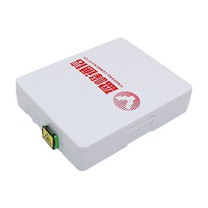Radiation loss caused by fiber bending
The optical fiber is soft and can be bent, but after bending to a certain extent, although the optical fiber can guide light, it will change the transmission path of light. The transmission mode is converted into a radiation mode, so that a part of the light energy penetrates into the cladding or passes through the cladding as a radiation mode and leaks out, resulting in loss. When the bending radius is greater than 5-10cm, the loss caused by the bending can be ignored.
Usually we see fiber optic cables with a white sheath. After the fiber is in the home, the technician will roll up these white fiber optic cables and tell you that this is an optical fiber cable and cannot be folded. Try to keep it in a hidden place. Don't touch it. Although, generally you will not listen carefully, but this is by no means alarmist. If you accidentally touch it when moving objects near the optical fiber, it will damage the optical fiber and affect the network speed.
What should I do if the fiber is damaged?
Once the pipeline is broken, we need the help of an optical fiber fusion splicer. Generally speaking, if something is broken, it needs to be repaired. The loss of the optical fiber is not called repairing the optical fiber, but the optical fiber needs to be spliced.
Home and business fiber is very different
It can be said that the enterprise fiber is superior to the fiber used in the home in terms of transmission speed and resistance to loss. When you walk into a data center, you will find that there are not only optical fibers, but also optical cables. The optical cable is also a kind of optical fiber, and the inside of the optical cable is also composed of multi-core optical fibers, so it is thicker and has a stronger transmission capacity.
If we want to distinguish enterprise fiber, we have to understand the concepts of single-mode and multi-mode. The standard for distinguishing between single-mode and multi-mode is the difference in signal transmission mode in the fiber. The core size of single-mode is generally 8--10um. In single-mode, the signal propagates along a straight line, which is a mode propagation.
The multi-mode fiber core is relatively large, 50um or 62.5um, which can transmit multiple modes at the same time.
Single-mode and multi-mode comparison
When companies choose fiber, they must consider their own transmission distance and transmission bandwidth. Generally single-mode is used in long-distance (more than 5 miles) transmission, and our fiber-to-the-home uses single-mode fiber. The multi-mode is concentrated in the short-distance complex signal transmission, it can be vertical avoidance and short-distance building group wiring within 550 meters of Ethernet. In other words, although single-mode fiber has a low signal attenuation rate and a high transmission speed, multi-mode fiber is the most widely used mode in enterprise applications.






